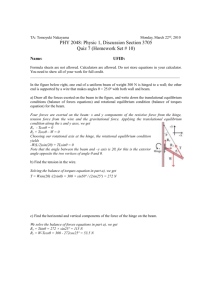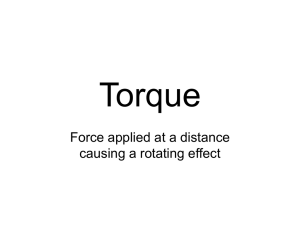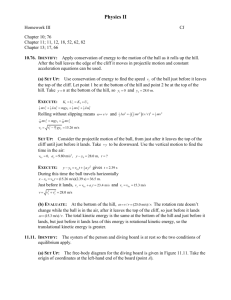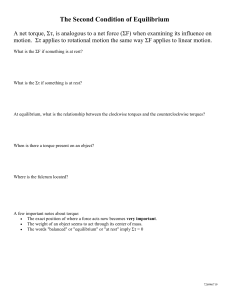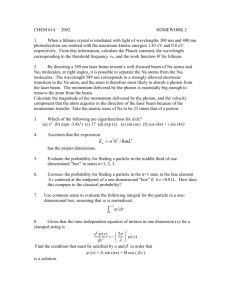Rotary Homework #1:
advertisement
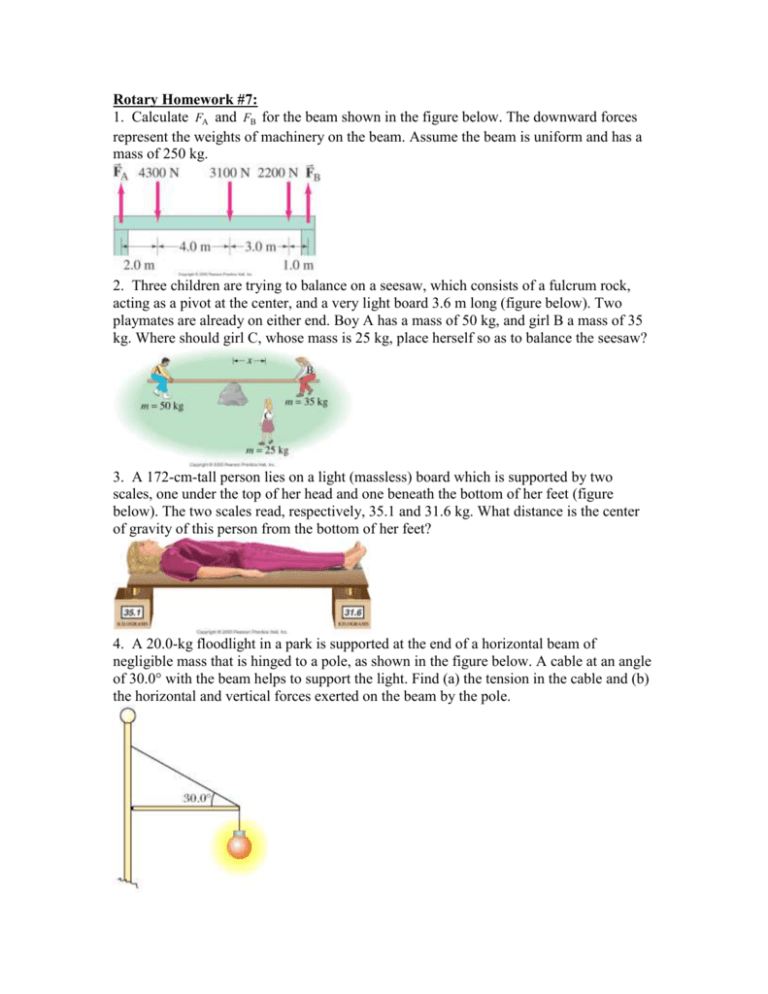
Rotary Homework #7:
1. Calculate FA and FB for the beam shown in the figure below. The downward forces
represent the weights of machinery on the beam. Assume the beam is uniform and has a
mass of 250 kg.
2. Three children are trying to balance on a seesaw, which consists of a fulcrum rock,
acting as a pivot at the center, and a very light board 3.6 m long (figure below). Two
playmates are already on either end. Boy A has a mass of 50 kg, and girl B a mass of 35
kg. Where should girl C, whose mass is 25 kg, place herself so as to balance the seesaw?
3. A 172-cm-tall person lies on a light (massless) board which is supported by two
scales, one under the top of her head and one beneath the bottom of her feet (figure
below). The two scales read, respectively, 35.1 and 31.6 kg. What distance is the center
of gravity of this person from the bottom of her feet?
4. A 20.0-kg floodlight in a park is supported at the end of a horizontal beam of
negligible mass that is hinged to a pole, as shown in the figure below. A cable at an angle
of 30.0° with the beam helps to support the light. Find (a) the tension in the cable and (b)
the horizontal and vertical forces exerted on the beam by the pole.
5. A shop sign weighing 245 N is supported by a uniform 155-N beam as shown in the
figure below. Find the tension in the guy wire and the horizontal and vertical forces
exerted by the hinge on the beam.
6. A 500-N uniform rectangular sign 4.00 m wide and 3.00 m high is suspended
from a horizontal, 6.00-m-long, uniform, 100-N rod as indicated in the figure at
right. The left end of the rod is supported by a hinge, and the right end is
supported by a thin cable making a 30.0° angle with the vertical. (a) Find the
tension T in the cable. (b) Find the horizontal and vertical components of force
exerted on the left end of the rod by the hinge.
7. A hungry 700-N bear walks out on a beam in an attempt to retrieve some “goodies”
hanging at the end (Fig. P8.20). The beam is uniform, weighs 200 N, and is 6.00 m long;
the goodies weigh 80.0 N. (a) Draw a free-body diagram of the beam. (b) When the bear
is at x = 1.00 m, find the tension in the wire and the components of the reaction force at
the hinge. (c) If the wire can withstand a maximum tension of 900 N, what is the
maximum distance the bear can walk before the wire breaks?
8. {Bonus Question} What minimum horizontal force F is needed to pull a wheel of
radius R and mass M over a step of height h as shown in the figure below R h?
(a) Assume the force is applied at the top edge as shown.
(b) Assume the force is applied instead at the wheel’s center.
Solutions:
1. The beam is in equilibrium, and so both the net torque and net force on it must be zero. From
the free-body diagram, calculate the net torque about the center of the left support, with
counterclockwise torques as positive. Calculate the net force, with upward as positive. Use
those two equations to find FA and FB .
F1
FA
x1
x2
x5
F x x
B
FB
1
2
F3
F2
x3
x4
FB
mg
x3 x4 F1 x1 F2 x1 x2 F3 x1 x2 x3 mgx5
F1 x1 F2 x1 x2 F3 x1 x2 x3 mgx5
x1 x2 x3 x4
4300 N 2.0 m 3100 N 6.0 m 2200 N 9.0 m 250 kg 9.8 m s 5.0 m
2
10.0 m
5925 N 5.9 103 N
F F
A
FB F1 F2 F3 mg 0
FA F1 F2 F3 mg FB 9600 N 250 kg 9.8 m s 2 5925 N 6125 N 6.1 103 N
2. From the free-body diagram, the conditions of equilibrium are used to find the location of the
girl (mass mC ). The 50-kg boy is represented by mA , and the 35-kg girl by mB . Calculate
torques about the center of the see-saw, and take counterclockwise torques to be positive.
The upward force of the fulcrum on the see-saw F causes no torque about the center.
m g L m gx m g L 0
A
x
3.
1
2
mA mB
mC
C
L
1
2
B
1
2
50 kg 35 kg 1
2
25 kg
L
3.6 m 1.1 m
x
mA g
The person is in equilibrium, and so both the net torque and net force
must be zero. From the free-body diagram, calculate the net torque
about the center of gravity, with counterclockwise torques as
positive. Use that calculation to find the location of the center of
gravity, a distance x from the feet.
FB x FA L x 0
x
FA
L
mA g
L
mA
L
35.1 kg
FA FB
mA g mB g
mA mB
31.6 kg 35.1 kg
The center of gravity is about 90.5 cm from the feet.
x
L-x
FA
1.72 m
mC g
F
FB
mg
9.05 101 m
mB g
4. (a) Consider the torques about an axis
perpendicular to the page and through the
left end of the horizontal beam.
T sin 30.0 d 196 N d 0 ,
giving T 392 N
(b) From Fx 0 ,
H T cos30.0 0 , or
H 392 N cos30.0 339 N to the right
From Fy 0 , V T sin 30.0 196 N 0
or V 196 N 392 N sin 30.0 0
5. The beam is in equilibrium. Use the conditions of equilibrium to calculate
the tension in the wire and the forces at the hinge. Calculate torques
about the hinge, and take counterclockwise torques to be positive.
FT sin l2 m1 g l1 2 m2 gl1 0
FT
1
2
m1 gl1 m2 gl1
l2 sin
1
2
155 N 1.70 m 245 N 1.70 m
1.35 m sin 35.0o
FT
FH
m1g
l1 2
l2
l1
708.0 N 7.08 10 N
2
F
F
x
FH x FT cos 0 FH x FT cos 708 N cos 35.0o 579.99 N 5.80 102 N
y
FH y FT sin m1 g m2 g 0
FH y m1 g m2 g FT sin 155 N 245 N 708 N sin 35.0o 6.092 N 6 N down
m2g
6. Consider the torques about an axis perpendicular to the page through the left end of
the rod.
0 T
100 N 3.00 m 500 N 4.00 m
6.00 m cos30.0
T 443 N
Fx 0 Rx T sin30.0 443 N sin30.0
R x 221 N tow ard the right
Fy 0 Ry T cos30.0 100 N 500 N 0
R y 600 N 443 N cos30.0 217 N upw ard
7. (a) See the diagram below:
(b) If x = 1.00 m, then
leftend 0 700 N 1.00 m 200 N 3.00 m
80.0 N 6.00 m T sin60.0 6.00 m 0
giving
T 343 N
Then, Fx 0 H T cos60.0 0 , or H 343 N cos60.0 171 N
and
Fy 0 V 980 N + 343 N sin60.0 0 , or V 683 N
(c) When the wire is on the verge of breaking, T = 900 N and
leftend 700 N xm ax 200 N 3.00 m
80.0 N 6.00 m 900 N sin60.0 6.00 m 0
which gives xm ax 5.14 m
8. (a) If the wheel is just lifted off the lowest level, then the only
forces on the wheel are the horizontal pull, its weight, and the
contact force FN at the corner. Take torques about the corner
point, for the wheel just barely off the ground, being held in
equilibrium. The contact force at the corner exerts no torque
and so does not enter the calculation. The pulling force has a
lever arm of R R h 2 R h , and gravity has a lever arm of
x , found from the triangle shown.
x
2R h
R 2 R h h 2R h
Mg
FN
x
2
Mgx F 2 R h 0
F
.
F
h 2R h
Mgx
Rh
x
h
Mg
Mg
2R h
2R h
2R h
(b)
The only difference is that now the pulling force has a lever arm
of R h .
Rh
Mgx F R h 0
F
Mgx
Rh
Mg
R
F
Mg
h 2R h
Rh
x
